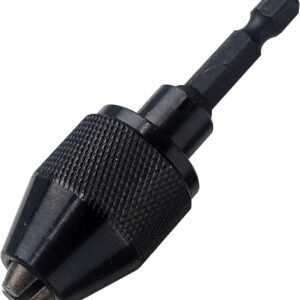Is Klein Tools ET310 the best circuit breaker finder? Read this detailed review now!
Is Klein Tools ET310 the best circuit breaker finder? Read this detailed review now!
- Exceptional Accuracy and Reliability: The tool consistently identifies the correct circuit breaker, even in complex setups, ensuring precise and efficient troubleshooting.
- User-Friendly Design: Its lightweight structure, clear indicators, and simple instructions make it accessible for both professionals and beginners.
- Durability and Build Quality: Constructed with high-quality materials, it’s designed to withstand regular use and maintain performance over time.
- Integrated GFCI Tester: The built-in GFCI tester adds an extra layer of functionality, allowing quick and seamless safety checks for outlets.
As an Amazon Associate I earn from qualifying purchases.
Description
A Handy Tool for Electrical Work
As someone who frequently tackles small home improvement and electrical projects, I’ve had my fair share of headaches trying to identify the correct circuit breaker for specific outlets. The frustration of flipping through mislabeled or faded breaker panels is all too familiar. When I got my hands on this circuit breaker finder with its integrated outlet tester, I was cautiously optimistic. Having spent a few weeks testing it out in various scenarios, I’m ready to share the good, the bad, and the in-between.
Features and Usability
Using this tool daily has been an eye-opener. It’s a two-part system—there’s a transmitter that plugs into an outlet and a receiver that scans the breaker panel. The first time I tried it, I was amazed. Plugging the transmitter into an outlet in my living room, I headed to the breaker panel in the basement. The receiver chirped excitedly as I hovered over the correct breaker, and the LED indicators lit up unmistakably. No guesswork, no flipping random switches—just precise and accurate results.
The built-in GFCI tester on the transmitter was another pleasant surprise. Testing the GFCI outlets in my kitchen, I appreciated how it clearly indicated whether the wiring was correct and if the GFCI was functioning properly. It even tripped the GFCI outlet as part of the test, which I found reassuring since it confirmed proper functionality. That’s not just a bonus feature; it’s a necessity for safety.
One thing that stands out is how lightweight and compact the tool is. Weighing just 7.2 ounces, it fits easily into my tool bag. The receiver has a dock for the transmitter, which ensures the two pieces stay together when not in use. It’s a small but thoughtful design touch.
Pros
- Accurate Circuit Identification: The receiver’s visual and audio cues make it almost foolproof to locate the correct breaker.
- Integrated GFCI Testing: The built-in outlet tester is a huge time-saver for checking wiring and functionality.
- Compact and Easy Storage: The docking system keeps everything in one place, reducing the risk of losing components.
- Works on Standard 90-120V Circuits: Broad compatibility makes it usable in most home and small office setups.
- User-Friendly Design: Straightforward instructions and operation mean even those new to electrical tools can use it.
Cons
- Occasional Inaccuracy: In older or messy breaker panels, the receiver sometimes identifies multiple breakers as possible matches.
- Requires Proper Wiring: The tool doesn’t work well if circuits aren’t wired correctly, which can be frustrating.
- No Storage Pouch Included: For the price, I would have appreciated a carry case or pouch.
- Not Ideal for Complex Panels: In multi-panel setups, the process can become tedious and require manual cross-checking.
- Potential Interference: Devices plugged into the same circuit can interfere with the signal, requiring them to be unplugged beforehand.
Comparison to Competitors
I’ve used other circuit breaker finders in the past, including models from Ideal and Fluke. Compared to those, this tool holds its own in terms of accuracy and ease of use. The Ideal model I had often struggled to differentiate between adjacent breakers, whereas this one performed better, albeit not perfectly. On the other hand, Fluke’s high-end tools tend to offer more reliability in complex setups but come at a significantly higher cost.
What really sets this product apart is the integrated GFCI tester. Many competitors either don’t include this feature or require an additional device for testing. That makes this product a more versatile choice for homeowners and professionals alike.
Cost Analysis and Value for Money
Pricing for tools like this can vary, and while this one isn’t the cheapest, it offers solid value for its versatility and build quality. The addition of the GFCI tester alone adds significant utility, making it a two-in-one tool. For DIY enthusiasts, it’s a great investment that simplifies what would otherwise be a time-consuming and frustrating process. Professionals might find it lacking in more complex scenarios, but for residential use, it’s hard to beat.
Additional information
| Brand | Klein Tools |
|---|---|
| Power Source | Corded Electric |
| Style | Circuit Breaker Finder |
| Color | Circuit Breaker Finder |
| Item Weight | 7.2 ounces |
| Item dimensions L x W x H | 10.96 x 2.16 x 1.39 inches |
| Min. Operating Voltage | 90 Volts |
| Measurement Type | Voltmeter |
| Maximum Operating Voltage | 120 Volts |
| UPC | 092644692406 |
| Manufacturer | Klein Tools |
| Global Trade Identification Number | 00092644692406 |
| Part Number | ET310 |
| Product Dimensions | 10.96 x 2.16 x 1.39 inches |
| Country of Origin | China |
| Item model number | ET310 |
| Batteries | 1 9V batteries required. (included) |
| Finish | Brushed |
| Material | PC & PC-ABS housing and electronic components |
| Pattern | Breaker Kit |
| Shape | Rectangular |
| Voltage | 120 Volts |
| Item Package Quantity | 1 |
| Special Features | Transmitter docks in Receiver Transmitter integrated GFCI outlet tester in receiver |
| Included Components | Includes Transmitter, Receiver, user manual, and 9V battery for Receiver |
| Batteries Included | Yes |
| Batteries Required | No |
| Date First Available | April 15, 2019 |














